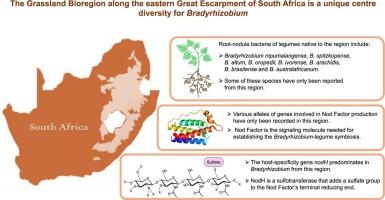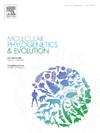来自非洲特有中心的豆科阿吉兰与具有独特共生基因的新型慢生根瘤菌物种有关。
IF 3.6
1区 生物学
Q2 BIOCHEMISTRY & MOLECULAR BIOLOGY
引用次数: 0
摘要
考虑到几个主要是南非特有的金雀花属占据豆科系统发育树的基础位置,非洲的这一地区被认为是这个豆科部落多样化的原始中心。尽管南非在金雀花科进化中的重要性,但几乎所有的研究都集中在根瘤菌在地中海盆地或美洲的多样性中心的根瘤菌。因此,本研究旨在鉴定和表征与大悬崖相关的草原生物群系相关的根瘤菌菌株,该地区占次大陆东部景观的主导地位,并将其与剩余多样性中心的慢生根瘤菌结核gensteae进行比较。通过对5个清洁基因(dnaK、glnII、gyrB、recA和rpoB)的系统发育分析,将18株慢生根瘤菌分为5个支持良好的类群。其中3种与花生芽孢杆菌、巴西芽孢杆菌/巴西芽孢杆菌同生。australafricum和b.ivorense,而剩下的两个似乎是科学上的新发现。在使用平均核苷酸身份(基因组相关性度量)和某些表型特征确认它们的新颖性后,我们认为它们是新物种,并提出了B. spitzkopense sp. nov (Arg816Ts)和B. mpumalangense sp. nov (arg237lt)的名称。nodA基因序列的系统发育分析表明,无论其物种身份如何,约有一半的被检查菌株含有仅在大悬崖草原生物群系中已知的等位基因,这些等位基因以前在该地区特有的结瘤crotalariae属慢生根瘤菌菌株中检测到。基于基因组的数据分析和先前的研究进一步表明,具有这些独特的nodA等位基因的菌株通常编码nodH基因,其产物在Nod因子(建立固氮共生的信号分子)上增加了硫酸盐部分。剩下的菌株没有在南非和世界其他热带地区常见的da等位基因。此外,他们的基因组缺乏nodH,但编码nodZ基因,该基因参与Nod因子的集中。因此,我们的研究结果表明,原产于大悬崖草原生物群系的Genisteae(及其姊妹部落crotalariae)的根瘤通常与慢生根瘤菌菌株相关,但与地中海和美洲的慢生根瘤菌结核Genisteae不同。本文章由计算机程序翻译,如有差异,请以英文原文为准。

Argyrolobium legumes from an African centre of endemism associate with novel Bradyrhizobium species harbouring unique sets of symbiosis genes
Given that several, mainly endemic South African Genisteae genera occupy basal positions in legume phylogenetic trees, this region of Africa is considered a primaeval centre of diversification of this legume tribe. Despite the importance of South Africa in Genisteae evolution, almost all studies have focused on rhizobia nodulating Genisteae in their centres of diversity in either the Mediterranean Basin or the Americas. Therefore, this study aimed to identify and characterize rhizobial strains associated with Argyrolobium species native to areas of the Grassland biome associated with the Great Escarpment, which dominates the subcontinent’s eastern landscape, and compare these to bradyrhizobia nodulating Genisteae in other centres of diversity. Phylogenetic analyses of five housekeeping genes (dnaK, glnII, gyrB, recA, and rpoB) separated the 18 Bradyrhizobium strains examined into five well-supported groups. Three of these were conspecific with B. arachidis, B. brasilense/B. australafricanum and B. ivorense, while the remaining two appeared to be new to science. After confirming their novelty using Average Nucleotide Identity, a metric for genome relatedness, and certain phenotypic traits, we recognized them as novel species for which we proposed the names B. spitzkopense sp. nov. (Arg816Ts) and B. mpumalangense sp. nov. (Arg237LTs). Phylogenetic analyses of nodA gene sequences showed that about half of the strains examined, irrespective of their species identity, harboured alleles known only from the Grassland biome along the Great Escarpment that were previously detected in Bradyrhizobium strains nodulating Crotalarieae endemic to this region. Genome-based analyses of data from this and previous studies further showed that strains with these unique nodA alleles typically encode the nodH gene, the product of which adds a sulfate moiety to the Nod factor (the signalling molecule for establishing the nitrogen-fixing symbiosis). The remaining strains had nodA alleles commonly encountered elsewhere in South Africa and other tropical regions of the world. Also, the genomes of these other strains lacked nodH but encoded nodZ, the gene involved in the fucosylation of the Nod factor. Our findings, therefore, showed that the root nodules of Genisteae (and its sister tribe Crotalarieae) native to the Grassland biome along the Great Escarpment are often related Bradyrhizobium strains that are distinct from bradyrhizobia nodulating Genisteae in the Mediterranean and the Americas.
求助全文
通过发布文献求助,成功后即可免费获取论文全文。
去求助
来源期刊
CiteScore
7.50
自引率
7.30%
发文量
249
审稿时长
7.5 months
期刊介绍:
Molecular Phylogenetics and Evolution is dedicated to bringing Darwin''s dream within grasp - to "have fairly true genealogical trees of each great kingdom of Nature." The journal provides a forum for molecular studies that advance our understanding of phylogeny and evolution, further the development of phylogenetically more accurate taxonomic classifications, and ultimately bring a unified classification for all the ramifying lines of life. Phylogeographic studies will be considered for publication if they offer EXCEPTIONAL theoretical or empirical advances.

 求助内容:
求助内容: 应助结果提醒方式:
应助结果提醒方式:


